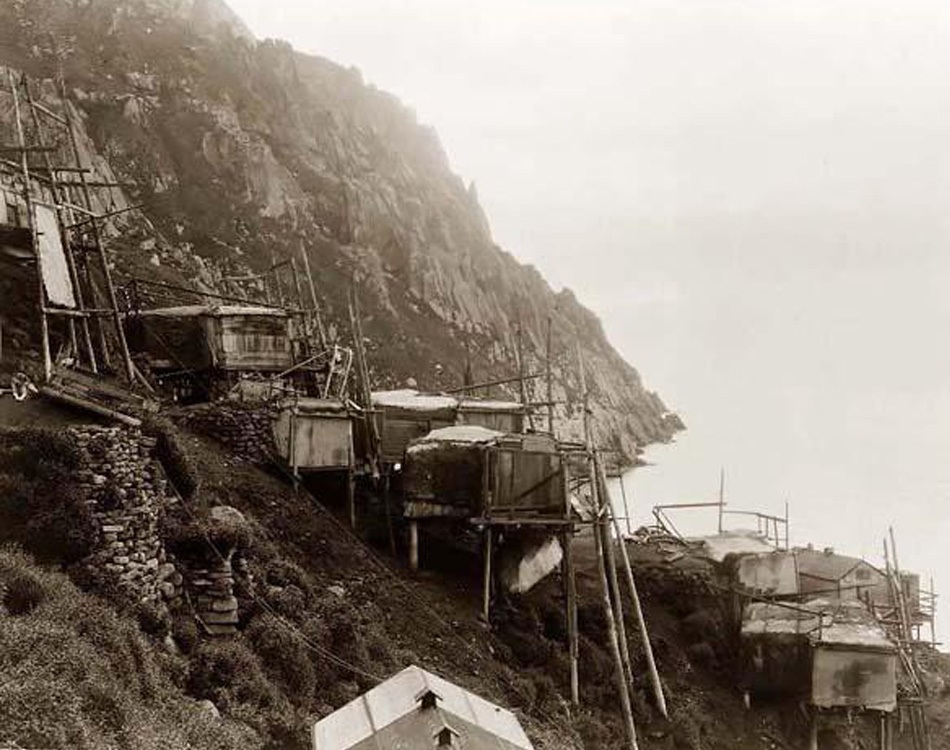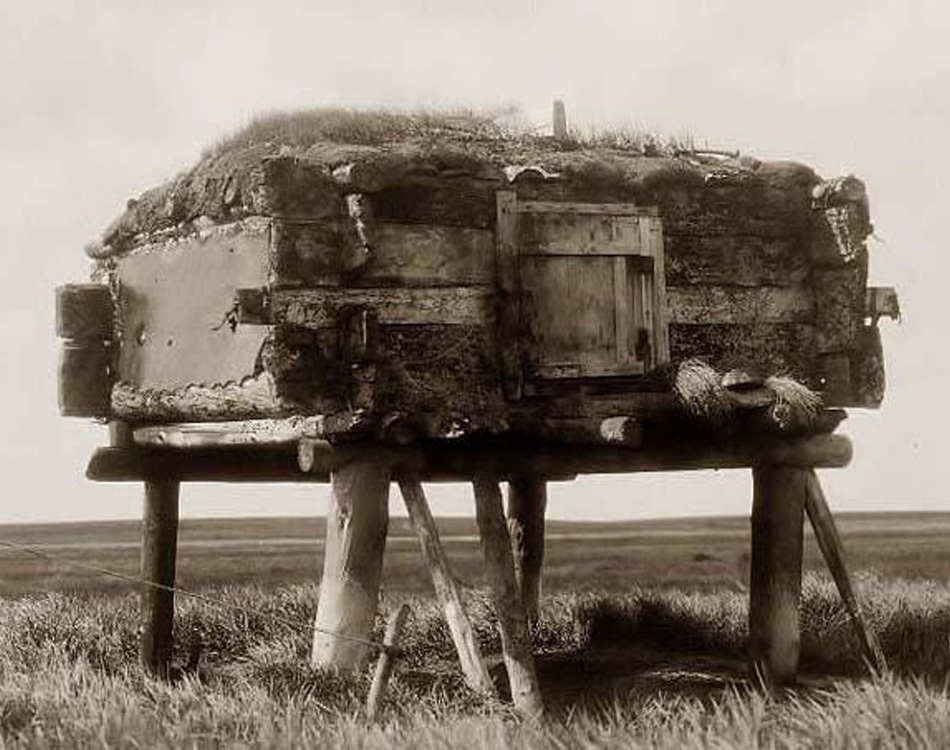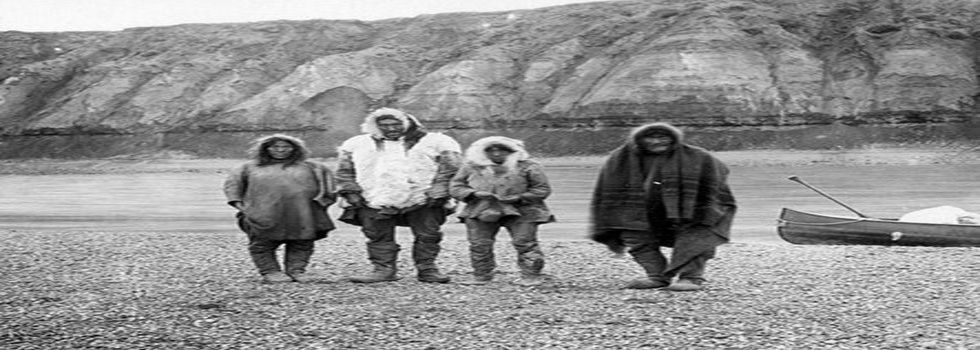
|
|||
Village of the Dead: Lake Anjikuni Mystery Disappearances
Source : http://en.wikipedia.org/wiki/Angikuni_Lake
http://all-that-is-interesting.com/the-mysterious-disappearance-of-the-anjikuni-people
In 1930, a newsman in The Pas, Manitoba, reported on a small Inuit village right off of Lake Angikuni. The village had always welcomed the fur trappers who passed through occasionally. But in 1930 Joe Labelle, a fur trapper well known in the village, found that all the villagers had gone. He found unfinished shirts that still had needles in them and food hanging over fire pits and therefore concluded that the villagers had left suddenly. Even more disturbing, he found seven sled dogs dead from starvation and a grave that had been dug up. Labelle knew that an animal could not have been responsible because the stones circling the grave were undisturbed. He reported this to the Royal Canadian Mounted Police, who conducted a search for the missing people; no one was ever found. One bitter night in November 1930, an exhausted Canadian fur trapper named Joe Labelle sought refuge from the cold and inadvertently stumbled across one of history’s most remarkable mysteries. The once-industrious Inuit village on the shores of Lake Anjikuni that Labelle had seen throughout his travels had vanished without a trace. Trudging through the fresh snow, Labelle cautiously approached the silent village in search of shelter. Still steaming, grey streaks emanated from a charred pot of stew and eerily wove themselves through the night sky. Clearly, Labelle mused, someone had to be around. Searching further, Labelle checked the huts and found clothing and food (two things you certainly wouldn’t leave behind if abandoning a village), both in large enough amounts to last the Inuits through winter. And yet, Labelle didn’t come across a single soul or sled dog; and what’s more, no footprints lay in the snow. Terrified, Labelle traversed the subzero terrains and made his way to the nearest telegraph office where, severely frostbitten, he sent a message to the Canadian Mounted Police for help. On arrival, they searched the village thoroughly and made a horrifying discovery. In the village burial ground, every grave had been unearthed and lay empty. An entire pack of sled dogs, which had been starved to death, was also found just beyond the village, having been buried under 12 feet of snow. To add to the mystery, the Mounties reported seeing a blue light that night, too artificial to be the Northern Lights, pulsing on the horizon before fading into the darkness. Despite numerous investigations, the 2,000 Inuits were never seen again and the tale of the missing Anjikuni tribe will be passed down through generations to come. On November 12, 1930, between 9:30 to 10:15 a.m. Joe Labelle, a Canadian fur trapper hiked in his frayed snowshoes and heavy deerskin coat. He was on his way to make his monthly visit to an Eskimo fishing village located on the pebbly shores of icy Lake Anjikuni in northwestern Canada. To make the trek bearable in the frigid cold, LaBelle had brought with him a flask filled with scotch. The flask had been a joke gift from his mother for his twenty-first birthday. His mother, a reformed alcoholic, had the flask engraved with the word "For Emergency Use Only". Labelle carried it with him everywhere and on this day Labelle made liberal use of the invigorating scotch during the long arctic journey. It helped keep the blood flowing to his freezing extremities. Soon the contents of that flask would aid him in dealing with a strange sight lying just ahead. Used to the excited barks of the village dogs as he approached on the single snow covered trail to the village, Labelle was troubled by a unusual quiet which met him. As he entered into the village proper, the quiet continued, broken only by the crunching of his boots on the surface of the crusted snow. Labelle later reported to the NorthWest Journal writer George Savarvio that he immediately thought this silence was ominous, bizarre. Once he entered the village and saw it empty of man or animal, his stomach tightened and his heart raced. Normally, the fishing village was a noisy, lively, bustling settlement with 2,500 Eskimos and a large number of dogs and other animals. There was rarely a hour of daylight inactivity in the village: from the first flicker of the morning sun over eastern Mount Kilajomo to the sun’s glowing red-orange setting at the western Norjii straits, there was bustling throughout, with the Eskimos going and coming in their home made, storm-sturdy kayaks, while the few white visitors powered their comings and goings in their noisy, odorous diesel powered boats.
The Mack Shack gave few clues. MacKenzie’s still was dismantled and the glass bottles which held some of the now evaporated brew were broken on the floor. The wooden chairs which Mackenzie set out for his customers were all missing. Labelle found Mackenzie’s whale bone and wood crutch was lying in pieces against the open door to his shack. Finally, Mackenzie’s diary was located. The diary was under his pillow and open to the date of the day before. But there was no entry. The entries for the weeks before indicated that there had been some strange lights seen in the sky. McKenzie, a brass and tacks man, made no speculation to the cause or meaning of these lights. The rest of the diary notations pertained to routine business matters, including a blow by blow account of a fist fight he had engaged in when collecting a debt. Such a fight was not unusual for MacKenzie. Despite his ailments and disability, he still had quick reflexes in his upper extremities. For a debtor foolish enough to come within MacKenzie’s arm length, his pearl hard knuckles could still crush human jaw bone. Except for the dissembled still, broken bottles and missing chairs, the rest of the Mack Shack was in its usual notorious disorder.  While looking about the Mack Shack, Labelle happened to squint out its one small window towards the east. Covering his eyes from the bright sun streaming in, he saw about four hundred yards away the red and orange flickering of a wood fire against the snow. Even at this distance he could see no one about the fire. Thinking here might be a clue where everyone had gone, Labelle set off for the fire. Upon reaching the fire, Labelle saw hanging over the diminishing flames a smoldering pot of seal fat stew, a traditional Eskimo mid morning meal. Upon Further investigation, he found ten to fifteen feet from the fire, a single pair of man’s undergarments. These were torn, and weathered and had the phrase "My Dear Benny" written in black magic marker on its hyper extended band waist. Lastly, on a nearby rock, there was a pair of round eyeglasses with thick, black rims. The rims were partially twisted and the lens were missing. Labelle instantly recognized these spectacles: these were the distinctive eyeglasses of the village’s Eskimo leader, Benitji "Benny"Atmoniji, who had died the year before from chickpox. Labelle recalled the funeral distinctly, as he attended out of respect for his friend of ten years. He recalled the chief had been buried with the trademark eyeglasses folded in his upper seal skin coat pocket along with his silver cigarette case filled with menthol Pell Mells, his favorite brand. As far as Labellee knew, the chief had only a single pair of glasses. As Labelle looked about the fire, Labelle saw that the only human footprints were his own. Now entirely frightened, Labelle decided to go for help. Labelle hurried to the nearest telegraph office, twenty-five miles away. Upon his arrival, he sent a message to the Royal Canadian Mounted Police. They arrived within twenty-four hours. Upon arrival they, too, were baffled by the mass vanishing act. Under Major Theodore Lestort, an enormous search party was sent out to look for the missing villagers. Joining them was writer George Savarvio of the NorthWest Journal. In the end, none of the villagers were found. However, the search party did unearth some rather strange findings. These findings are recorded in Savarvio’s five part article on the occurrence published in the NorthWest Journal in January 1931. Among the strange findings were the following. All the sleigh dogs belonging to the Eskimos were found wandering the surrounding area, and all were in surprisingly good condition and seemingly well fed. After an extensive hunt, another dog was found alive wandering near the Mack Shack. It had a man’s cologne sprinkled on its front coat. Its black lips were haphazardly covered in a woman’s red lipstick, and there was a woman’s necklace around its thick neck. Its hindquarters was covered in a woman’s undergarment. Labelle recognized it as Mack’s beloved dog, Juno, an eight year old Husky. Closer inspection revealed that someone had pierced the dog’s ears as if preparing them for ear rings.  The only injury to the dog had been to its from where something or someone had jammed a wedding ring on the left paw. Further strangeness was found at the village’s stone Catholic chapel. The villagers had long been christianized. A priest would visit once a month to conduct Mass. When searched, the chapel was desecrated with Unitarian and Universalist symbols. Then came the most chilling surprise of all; the search party discovered that all of the Eskimos’ ancestral graves had been dug up, the bones removed and village refuse dumped into the graves. Whoever or whatever had taken all the living villagers had also dug up the dead as well, even though the icy ground around the graves was as hard as stone. The sole grave left untouched was that of one of Punckii Akkailo, the ancestral leader and alleged founder of the village. There was no snow cover to the grave. Upon inspection the soil of the grave was found warm to the touch. Investigators dithered over whether to open the grave. There was a strong Eskimo taboo regarding the opening of graves. As the day advanced, the investigators argued, and the soil cooled. Soon the soil of the grave became ice cold and hard. Still fearful of violating Eskimo tradition by opening the grave, it was decided by the authorities to leave the grave alone. The authorities closed the investigation quickly. Within a year, the village was razed for reasons unexplained by the government. The village was no longer listed on government maps. A few commerical maps up to the mid-1950's did continue to list the village but with a parenthetical note that the village was abandoned. No current maps list the area. ALIEN ABDUCTION: In the latter half of the 20th Century, numerous ufologists speculated that the residents of this remote Canadian village might well have been the unsuspecting victims of one of the largest mass alien abductions in history. This hypothesis is based in no small part on the Laurents’ observation of the cylindrical, bullet-shaped object hurtling toward Anjikuni, as well as the bizarre blue lights seen by the Mounties in the night sky above the village.While the evidence supporting this theory is circumstantial at best, the thought is intriguing… as well as utterly horrifying. One must admit that just contemplating the notion of extraterrestrials swooping down and absconding away with the entire population of a village is the stuff from which nightmares are forged. DEMON ATTACK: Labelle himself told reporters that he believed that the Angikuni people were now missing due to a run-in with: “the Eskimos evil spirit Tornrark.” The demonic entity that Labelle referred to appears to be a misspelling of “Torngarsuk” — also known as: “Torngasak, Tornatik, Torngasoak, Tungrangayak and Tor-nar-suk” — who, according to Inuit legend, is a powerful sky deity who is the leader of a legion of malevolent spirits. It’s worth noting that Labelle, a supposed stranger to the region, was apparently familiar enough with its indigenous people and their customs to mention one of their most maleficent entities by name. Submit News/Videos/Links | Discuss article | Article Link | More Unsolved and Unexplained Mysteries |
More can be addded on request. Direct your requests at vinit@theunexplainedmysteries.com
